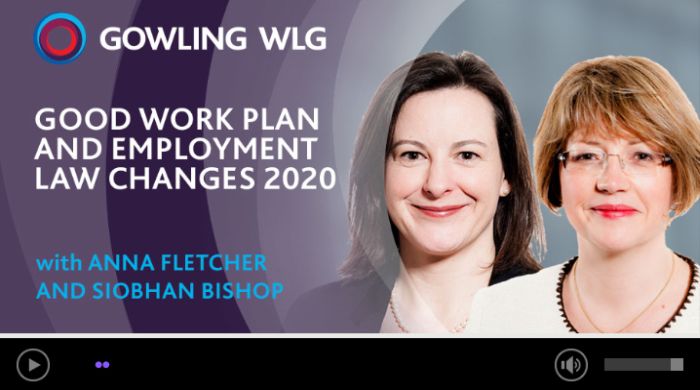What employment law changes are coming down the tracks in 2020 and beyond? Anna Fletcher and Siobhan Bishop discuss the Good Work Plan, future employment law changes will what they mean for organisations.

Siobhan Bishop: Hello and welcome. I am Siobhan Bishop a principal associate in the Employment, Labour& Equalities team and I am joined by Anna Fletcher, a Director in our team, and we are here to chat about the Government's vision for the future of the UK labour market also known as the Good Work Plan and what is coming down the tracks in employment law in 2020. So Anna, the first Government changes we saw in 2019 gave the right to a payslip for all workers and the requirement to outline hours for hourly paid workers on the payslip but there are some more significant changes coming in 2020. What are the key ones we are expecting in April?
Anna Fletcher: Well, one of the key changes from 6 April this year, Siobhan, will be the change to the provision of a section 1 statement. So that document that contains the principal terms and conditions of employment of employees. It is going to become a day one right, so instead of waiting eight weeks for the provision of the section 1 statement, employers are going to have to provide that, as it says, on day one. In fact the right is extended beyond the obligation to provide that section 1 statement to employees and it will be extended to workers, so that will mean that employers will have to identify who workers are. There will not be any qualifying period now. At the moment you have to work for a month before you are entitled to your section 1 statement, that will not be the case going forward and in fact employees who are currently employed, so your pre-6 April 2020 employees, will be entitled to ask for a new form section 1 statement.
In terms of the actual changes there is additional information that must be contained in a single document and that will necessitate the review of current contracts and section 1 statements to make sure that they are compliant. There continue to be risks for non-compliance and, in particular, there is no change to the current regime where employment tribunals can consider claims for breach of what is section 38 of the Employment Act 2002 but only where that claim for non-compliance is bolted on to another claim. So there is no freestanding complaint that can be made. The tribunals can award compensation on a "just and equitable" basis and they can award between two and four weeks' pay capped at the current £525 per week. So we may see more challenges but what is clear from the Employment Appeal Tribunal decision from last year called Govdata Limited v Denton is that if you correct the non- compliance before a claim is issued, then the tribunal will not award compensation.
Siobhan: And the other good thing is that the section 1 statement requirement for workers is only for those engaged on or after 6 April.
Anna: Yes, it is. Although there may well be just a drafting error in the regulations.
So the other change we are going to see from 6 April are changes in relation to agency worker rights. This really reflects the Good Work Plan focus on transparency. So the current arrangements, known as pay between assignments, or Swedish derogation arrangements, where agency workers are employed on a permanent basis and do not get pay parity will be removed. So that is something that employers are now looking at where they have cohorts of agency staff. Agency workers themselves are going to be entitled to a key fax document which can run to only two sides of A4 and that will contain information in relation to the name of the employment business, who is going to be paying the agency workers, what they are going to be paid, when they are going to be paid for their work, any benefits and deductions and then what is quite new is an actual calculation that is representative of the take home pay of that particular agency worker, so not an example, but something that is a real life worked description of what is going to be paid to the agency worker.
Siobhan: Ok thank you but there are a number of other consultations and proposals which the Government has made and some of those are more certain than others that they will be introduced but one of the key ones is about redundancy protection for pregnant women and new parents and extending that right which could clearly have a significant effect on those processes and a number of potential employees who have priority in the redundancy situation where there might be suitable alternative employment available, but what are the exact proposals, Anna?
Anna: Ok well, in response to the consultation that ended in April 2019 in July 2019 the Government announced that protection will be extended to women at the point at which they inform the employer of pregnancy and that can be a verbal informing of the employer by the employee as well as written. So there is a need, I think, there to have systems in place to ensure that that information is captured so that managers and HR are very clear about who has this protection. Then the provisions will extend protection for a further six months after a return to work from maternity and adoption leave, so that will not necessarily just be women, that will be men as well, and then there is a further proposal to extend that protection for those returning from shared parental leave, although it is unlikely that the rights will be identical because, of course, shared parental leave can be taken in shorter discontinuous blocks. So we need to see quite how that protection is going to be extended but it is clear that you could end up in a situation where you have a number of individuals with precisely the same protection but when it comes to the preferential treatment that is provided for, it is going to be difficult to see how that might be applied in practice.
Siobhan: Ok so another change to be introduced in April is for parental bereavement leave and what rights will employees have for this?
Anna: It will come into force in April 2020. This will be a day one right, it will apply to not just parents but people who are primary carers in relation to the death of a child under the age of 18 or a still birth after 24 weeks and it will give those parents and primary carers the right to two weeks leave. That leave will be paid if those individuals have 26 weeks' service and it means that the employers who have not yet dealt with the issue of bereavement will need to go and check current policies to see, for example, if compassionate leave policies can be adapted or whether they are proposing to have entirely standalone policies.
Siobhan: Ok but that is not it, there are even further proposals coming down the tracks, what are those?
Anna: There are three particular proposals in relation to the support for families that have been consulted on. The first is a review of parental leave and by parental leave I do not mean the specific right to parental leave but this is a more generic term to cover maternity, shared parental and paternity leave so all of the sort of family friendly leaves that we have at the moment. The thinking there is that we need to look at leave and pay to see whether we are ahead of the curve. We certainly are when it comes to maternity leave, for example, but not so much in relation to paternity leave. There is an interesting suggestion that we might just start again, wipe the slate clean and come up with a model policy that just covers one single form of parental leave and that would be quite interesting because it would remove some of the inconsistencies that we have at the moment in relation to notification periods, eligibility and so on.
There are further proposals in relation to neo-natal care. The number of babies born prematurely and, in fact, the number of babies born at full term, which is defined at 37 weeks gestation, who spend significant period of time in neo-natal care means that parents do not get that opportunity to go home and bond with their new born baby and so it is recognised that that neo-natal care, that time that is spent in hospital, eats into the paternity and maternity leave that parents may be taking. So the aim is that there will be provision that allows fathers at the end of paternity leave and mothers at the end of maternity leave to add on weeks that the child spent in neo-natal care where the child has been in neo-natal care for at least two weeks, although it is not clear yet how much leave will be provided for. Then, subject to eligibility conditions, that leave will be paid, presumably at the same sort of rates as we have paid in relation to maternity, paternity, adoption leave and so on.
And then further consultation in relation to flexible working, the idea being that it is difficult if employees or prospective employees do not know whether a particular organisation has a view relating to flexible working to actually ask those sorts of questions at interview. So the suggestions are that large employers, so employers with more than 250 employees, will have to publish their policies on their website so it is clear whether or not there is provision for flexible working and also the situation where all job adverts will be advertised in terms of being whether they are flexible, or not, so those things are being considered at the moment.
There is also further consultation in relation to something that is referred to as one-sided flexibility. That is where the employer gets all the benefits of having a flexible work force but the individual employee or worker gets all the risk. So there are risks in relation to unpredictability, so not knowing whether or not your shift is going to be cancelled until very short notice. Also issues around the problems of income because income fluctuates and the issues that that creates. Then there are also issues in relation to concerns about asserting your rights when you are in a fairly vulnerable position. So the proposal is that those with 26 weeks' service will be able to request a stable contract. It will only be a right to request and it is not clear what the enforcement process will look like and the penalties that will be applied but you might assume that it will look very similar to the right to request flexible working. Then there is the possibility of a requirement that the employer provide reasonable notice of work schedules and compensation for any shifts that are cancelled or curtailed. So all these are to help protect the more vulnerable workers in this situation, so that the balance of power is equalised.
A final consultation is in relation to reducing ill-health job losses. This is going to apply to individuals with health conditions that do not necessarily amount to a disability for the purposes of the Equality Act. In those circumstances, individuals will have a right to request work or work place modifications. So our suspicion is it will be very like reasonable adjustments but in circumstances where the employer will be able to refuse on the basis that the employer has legitimate business grounds for doing so and there is also going to be reform to statutory sick pay and more robust enforcement of statutory sick pay.
Siobhan: So wow that is quite a lot on the table coming down the tracks.
Anna: It is.
Siobhan: But it is not all, looking at the Queen's speech there are a few extra things in there as well.
Anna: Yes, much of what I have talked about is contained in the Queen's speech. In addition there is a proposal that there will be one week's additional leave for unpaid carers and also some provisions in relation to flexible working by default. That is going to be subject to further consultation and obviously we have Brexit and the Withdrawal Agreement Bill removed from the Withdrawal Agreement Bill recently were the safeguarding provisions in relation to employment rights but we are reassured that those will appear in the employment bill and a proposal that regulations might be passed that will permit our courts to basically disregard decisions of the Court of Justice of the European Union. So you can see some of those more contentious issues for example around some of those judgements concerning the calculation of holiday pay and the carry-over of holiday pay perhaps being the subject of change at a domestic level if those regulations were to be introduced.
Siobhan: Many thanks Anna, so that was a full run down of what to expect and what to watch out for in the coming year. Anna, thanks for highlighting those key issues.
Read the original article on GowlingWLG.com
The content of this article is intended to provide a general guide to the subject matter. Specialist advice should be sought about your specific circumstances.

